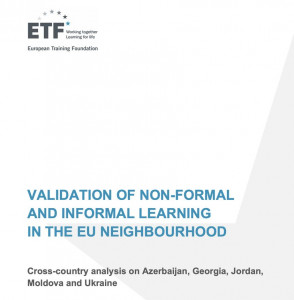The European Education Fund (EDF) recently published the report “Validation of non-formal and informal learning in the EU neighborhood: Cross-country” on its website analysis on Azerbaijan, Georgia, Jordan, Moldova and Ukraine), which was prepared as part of the project to modernize the qualifications of the EDF. It includes analysis of data collected between June and September 2021 in Azerbaijan, Georgia, Jordan, Moldova and Ukraine.
Inspired by European achievements, EU neighboring countries have created systems for the validation of non-formal and informal learning (VNIN). Since 2018, the ETF has been monitoring the validation of non-formal and informal learning in the countries of the Western Balkans and Turkey, which are part of the European Qualifications Framework. However, the development of the VNIN system goes beyond the borders of European countries. VNIN is a central part of the education systems of developing countries to become lifelong learning systems. There are many contexts in which VNIN can play an important role, including upskilling and reskilling (especially in the context of the green and digital transition), active labor market interventions, access to higher education and vocational training, reintegration of migrants, and completion primary and secondary education.
Note that the ETF intends to monitor the development of VNIN in all partner countries as one of the key tools to support lifelong learning and professional development. In 2021, the ETF conducted research in Azerbaijan, Georgia, Jordan, Moldova and Ukraine. This report summarizes the key findings of the study and provides recommendations based on the study findings that can be used by all partner countries to analyze their VNIN systems.
It is worth emphasizing that changes in legislation and policy regarding VNIN in all five countries occurred relatively recently and accelerated over the past 5 years. Some countries are creating validation mechanisms based on existing systems that need to be revised and/or expanded. This was the case in Georgia, Jordan and Ukraine.
Most of the new initiatives focus on validation for professional qualifications. VET systems in the field of vocational education and training differ significantly in terms of implementation, legislation and practice in the five partner countries. With the exception of correspondence examinations, this is the only evidence of the development of VNIN in the higher education sectors that has been found in Ukraine.
The report notes that considerable attention has been paid to implementing accreditation or authorization mechanisms for validation centers and ensuring a robust assessment process to strengthen the credibility of the mechanism. Some investment has been made in the initial capacity building of validation specialists and additional procedures have been developed to support the use of the service.
Instead, not enough attention has been paid to identifying who can benefit from validation and why. According to the report, public awareness of validation is low, information is insufficient, and collaboration between stakeholders is not yet established. The report notes that there is no sustainable funding mechanism for validation.
Funding often depends on fees or projects supported by the international community. Disadvantaged populations do not receive sufficient support to participate in validation, and validation providers do not see a commercial case for expanding services and do not have sufficient incentives to offer flexible learning trajectories.
After the pilot activities of the project, the level of use of services was lower than expected. There is also the risk that low success rates have undermined future demand. This requires a better understanding of the demand for validation, greater attention from the beneficiary’s perspective, and increased efforts in candidate training and pre- and post-validation support.
The report also provides recommendations for further development of validation systems in the countries studied, in particular with regard to raising awareness of the potential use of validation and clarifying the needs of various stakeholders, as well as ensuring access to further training and qualifications and their linkage with validation services. You can read more about the materials of the report at the following link:
